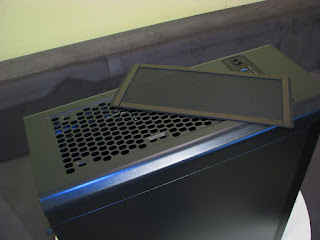 I have been using mousemat - as it's hard to call something sized 900x400x4mm a mousepad ;) - from the title of this post for a month now. Today, I'd like to share my insights from the past month with you.
I have been using mousemat - as it's hard to call something sized 900x400x4mm a mousepad ;) - from the title of this post for a month now. Today, I'd like to share my insights from the past month with you.The name of SteelSeries mousepads - QcK - should indicate that it's a speed type surface, which means that your mouse will glide with the least possible friction. Despite its name, QcK surface is rather a "slow", control type, which will allow you to have better control over your mouse and better precision. It's not a drawback, but depending on your gaming style, favorite mouse and types of games you play - it will matter. Initial glide on QcK has some friction to it, but after that it's rather smooth, which allows higher precision movements.
The mousemat is, sadly, not braided, but the underside looks very solid and it adheres to my varnished desk well enought, that if I want to move it, I have to pick the whole thing up from the table top.
From my observations, the mat soaks liquids very quickly, which might be an issue for anyone whose hands get sweaty during gaming. QcK will accumulate sweat, collect dirt and germs, and the surface will loose some of its parameters in those spots. As it has some rough texture to it, QcK attracts dust easily. I didn't have a chance to wash it in washing machine (or use other methods for that matter) yet, but other users said they were able to do it without any issues, if you use a protective bag so the edges won't shred.
This mousepad is 4mm thick and it's quite hard. It's hard enough that your mouse won't have any issues even if you tend to push it firmly, but at the same time is soft enough to rest your wrists on it while gaming or typing :) And when you take a break between matches of your favourite games - it just begs you to lay your head on it and doze off :D
The size of this thing will allow for a lot of comfort when it comes to space for your mouse. You can easily put a keyboard on it and still have more than enough space to game with low DPI settings. 900mm in case of smaller desks is usually the whole width of a table top, so be sure to measure if you can fit it on yours :)
Personally I'm delighted to use QcK XXL. It fits my desk space perfectly, allows me to comfortably change positions during gaming sessions without moving it and my banged up keyboard without rubber feet won't move an inch anymore ;)
If I was to assign SteelSeries a score for this product, it'd be solid 4+/5. The biggest drawbacks are: lack of braiding on edges and the way it absorbs water. I only hope I will be able to clean it easily and that lack of braiding won't make it less durable. I strongly recommend QcK XXL if you're looking for a large mousemat for your battlestation :)
Mousemat has been bought at X-kom store and gifted to me by the Wife ;)



















